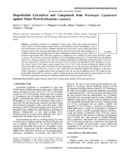| dc.contributor.author | Opiyo, Sylvia A. | |
| dc.contributor.author | Manguro, Lawrence O.A. | |
| dc.contributor.author | Akinyi, Dorothy | |
| dc.contributor.author | Ochung, Anjeline A. | |
| dc.contributor.author | Ochieng, Charles O. | |
| dc.date.accessioned | 2017-10-05T11:19:33Z | |
| dc.date.available | 2017-10-05T11:19:33Z | |
| dc.date.issued | 2015 | |
| dc.identifier.citation | The Natural Products Journal, 2015, Vol. 5, No. 4 | en_US |
| dc.identifier.uri | http://www.ingentaconnect.com/content/ben/npj/2015/00000005/00000004/art00004?crawler=true | |
| dc.identifier.uri | http://hdl.handle.net/123456789/2843 | |
| dc.description.abstract | Agricultural production is constrained by insect pests, which cause serious post-harvest losses of up to 43% in developing countries. Maize weevil (Sitophilus zeamais Motschulsky.) is one of the most destructive pests of maize. Synthetic chemicals have been used to protect stored grain from damage by insects. The increasing knowledge about the harm derived from the indiscriminate use of synthetic insecticides has prompted research aimed at finding safe methods of pest control. Efficacy of extractives and isolates from Warburgia ugandensis (Canellaceae) were evaluated for maize grain protection against S. zeamais. The oil extract was the most repellent (P >0.05) with repellence distance of 6.37 within 2-hour exposure duration followed by n-hexane extract (6.20 cm).The most repellent compounds were mukaadial (6) and polygodial (1) (5.43 and 4.83 cm, respectively). Essential oil was the most toxic (P >0.05) to the weevils and showed 100% mortality at 21 days. The toxicity levels of the organic extracts ranged from 18.3 to 78.0% with n-hexane exhibiting the highest toxicity followed by ethyl acetate extract. Polygodial (1) and warburganal (2) were the most toxic compounds (70.0 and 65.0% respectively). The oil extract was as active as the Actellic dust and completely inhibited the emergence of the insect adults. Polygodial (1), ugandensolide (3) and warbuganal (2) had the best growth inhibition activity. The results from the present study indicate that W. ugandensis could be a useful alternative in stored grain protection against maize weevil and the isolated compounds could be good candidates as phytoinsecticidal agents against insect pests. | en_US |
| dc.language.iso | en | en_US |
| dc.publisher | Bentham Science Publishers | en_US |
| dc.subject | Biopesticidal agents | en_US |
| dc.subject | extracts | en_US |
| dc.subject | maize weevil | en_US |
| dc.subject | insect pests | en_US |
| dc.subject | isolates | en_US |
| dc.subject | Warburgia ugandensis | en_US |
| dc.title | Biopesticidal Extractives and Compounds from Warburgia Ugandensis against Maize Weevil (Sitophilus zeamais) | en_US |
| dc.type | Article | en_US |

